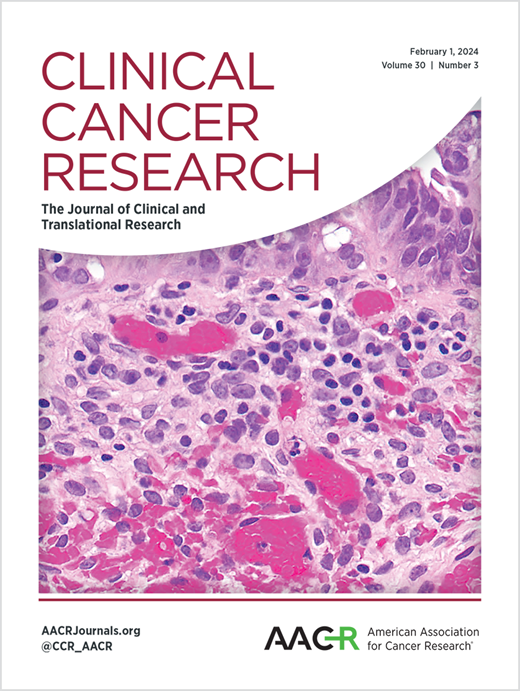Navtemadlin在idh野生型胶质母细胞瘤中的药代动力学、药效学和疗效的临床前建模
IF 10.2
1区 医学
Q1 ONCOLOGY
引用次数: 0
摘要
背景:Navtemadlin是一种有效的MDM2小分子抑制剂,已经完成了胶质母细胞瘤(GBM)的0期机会窗口研究。为了更好地解释临床数据,我们详细分析了纳替马德林在GBM患者来源的异种移植物(PDXs)中的药代动力学(PK)、药效学和疗效。方法:在MDM2扩增和不扩增的情况下,对GBM PDXs体外和体内对纳替马德林的反应进行表征。体内疗效与测量的血浆和肿瘤内药物水平相结合,建立了一个翻译的PK/疗效模型,比较PDX的有效暴露与0期患者样本的暴露。结果:在体外,纳替马德林在TP53野生型gbm中显示出强大的靶向活性。体内疗效与MDM2扩增状态密切相关。在皮下PDX中,当mdm2扩增的PDX剂量为25mg /kg时,navtemadlin显着延长了生存期,而在非扩增的PDX中,navtemadlin剂量为100mg /kg。中枢神经系统分布受血脑屏障外溢限制(Kp_brain=0.009)。在mdm2扩增的原位PDX模型中,navtemadlin在100 mg/kg时无效;当在血脑屏障外排不足(Rag-/- abcb1a -/- Abcg2-/-)小鼠中建立时,25 mg/kg可使存活率加倍。建立肿瘤PK/疗效模型,以25mg /kg有效剂量确定GBM疗效的靶暴露。在240 mg剂量水平的0期研究患者的16个肿瘤样本中,有3个模型暴露超过了这个阈值。结论:纳替马德林的疗效高度依赖于充分的脑渗透。我们的翻译PK/疗效模型表明,最低有效肿瘤暴露仅在少数GBM患者中实现。本文章由计算机程序翻译,如有差异,请以英文原文为准。
Pre-clinical Modeling of Navtemadlin Pharmacokinetics, Pharmacodynamics, and Efficacy in IDH-wildtype Glioblastoma
Background: Navtemadlin is a potent small molecule inhibitor of MDM2, which has completed a Phase 0 window of opportunity study in glioblastoma (GBM). To optimally interpret the clinical data, a detailed analysis of navtemadlin pharmacokinetics (PK), pharmacodynamics, and efficacy was performed in GBM patient derived xenografts (PDXs). Methods: Response to navtemadlin was characterized in vitro and in vivo in GBM PDXs with and without MDM2 amplification. Efficacy in vivo was integrated with measured plasma and intra-tumoral drug levels to develop a translational PK/efficacy model comparing exposure effective in PDX to exposure achieved in phase 0 patient samples. Results: In vitro, navtemadlin showed robust on-target activity in TP53 wild-typeGBM. In vivo efficacy strongly correlated with MDM2 amplification status. In subcutaneous PDXs, navtemadlin significantly extended survival when dosed at 25 mg/kg in an MDM2-amplified PDX, compared to 100 mg/kg in a non-amplified PDX. CNS distribution was limited by blood-brain barrier efflux (Kp_brain=0.009). In an MDM2-amplified orthotopic PDX model, navtemadlin was ineffective at 100 mg/kg; when established in mice with deficient blood-brain barrier efflux (Rag-/-Abcb1a-/- Abcg2-/-), 25 mg/kg doubled survival. A tumor PK/efficacy model was built to define target exposure for efficacy in GBM, using the effective 25 mg/kg dose. Modeled exposures exceeded this threshold in 3 (of 16) tumor samples from phase 0 study patients at the 240 mg dose level. Conclusion: Navtemadlin efficacy was highly dependent on adequate brain penetration. Our translational PK/efficacy model suggests that the minimum effective tumor exposures were achieved only in a minority of GBM patients.
求助全文
通过发布文献求助,成功后即可免费获取论文全文。
去求助
来源期刊

Clinical Cancer Research
医学-肿瘤学
CiteScore
20.10
自引率
1.70%
发文量
1207
审稿时长
2.1 months
期刊介绍:
Clinical Cancer Research is a journal focusing on groundbreaking research in cancer, specifically in the areas where the laboratory and the clinic intersect. Our primary interest lies in clinical trials that investigate novel treatments, accompanied by research on pharmacology, molecular alterations, and biomarkers that can predict response or resistance to these treatments. Furthermore, we prioritize laboratory and animal studies that explore new drugs and targeted agents with the potential to advance to clinical trials. We also encourage research on targetable mechanisms of cancer development, progression, and metastasis.
 求助内容:
求助内容: 应助结果提醒方式:
应助结果提醒方式:


